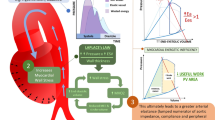Abstract
The authors suggest an analytical description for the time course of quantitative changes in STdepression observed during short-term myocardial ischemia provoked by a stress test. Phenomenologically, the tests carried out with 64 patients with coronary heart disease revealed four consecutive phases in the ischemic episode: a phase of progressive depletion of oxygen reserves, a phase of metabolic changes, and phases of rapid and slow recovery (a pattern observed in all the patients examined). The phases differ in amplitudes and time spans, presumably because of dissimilar underlying pathophysiologic mechanisms. The suggested mathematical expression gave a quite close approximation of each of the phases of the standard stress tests. The STdepression is interpreted as being the result of decreased conduction in metabolically impaired hypoxic cardiac myocytes.
Similar content being viewed by others
REFERENCES
Kuleshova, E.V., Persistent and Dynamic Coronary Obstruction in Angina Perctoris: Pathogenetic Signifi-cance, Influence upon Clinical Manifestations, Time Course, and Prognosis, Doctoral (Med.) Dissertation, St. Petersburg, 1991.
Di Mario, C., Strikwerda, S., Gil, R., et al., Response of Conductance and Resistance of Coronary Vessels to Scalar Concentrations of Acetylcholine: Assessment with Quantitative Angiography and Intracoronary Doppler Echography in 29 Patients with Coronary Artery Disease, Am. Heart J., 1994, vol. 127, no. 3, p. 514.
Mohr, R., Dinbar, I., Bar-El, Y., et al., Correlation between Myocardial Ischemia and Changes in Arterial Resistance during Coronary Artery Bypass Surgery, J.Cardiothorac. Vasc. Anesth., 1992, vol. 6, no. 1, p. 33.
Lichtlen, P.R., The Concept of Total Ischaemic Burden: Clinical Significance, Eur. Heart J., 1996, vol. 17, p.
Reimer, K.A., Murry, C.E., and Jennings, R.B., Cardiac Adaptation to Ischemia: Ischemic Preconditioning Increases Myocardial Tolerance to Subsequent Ischemic Episodes, Circulation, 1990, vol. 80, no. 10, p. 2226.
Marcassa, C., Galli, M., Parodi, O., et al., Maldistributionof Regional Myocardial Perfusion at Rest in Patients with Coronary Artery Disease and No Previous Myocardial Infarction, Evidenced by 99mTc-Sestamibi Scintigraphy, J. Nucl. Biol. Med., 1994, vol. 38, no. 3, p. 495.
Mikuniya, A., Fujino, Y., Higashiyama, A., et al., Evaluationof Myocardial Oxygen Extraction Dynamics in Syndrome X by Continuous Measurement of Coronary Sinus Oxygen Saturation and Its Relation to Clinical Features, Kokyu to Junkan, 1992, vol. 40, no. 5, p. 473.
Kaprielian, R.R., Cunning, M., Dupont, E., et al., Downregulation of Immunodetectable Connexin-43 and Decreased Gap Junction Size in the Pathogenesis of Chronic Hibernation in the Human Left Ventricle, Circulation, 1998, vol. 97, no. 7, p. 651.
Simonova, O.N., Roze, E.N., and Bondarenko, B.B., Pathophysiology of Short-Time Myocardial Ischemia: A Model for an Ischemic Reaction, Fiziol. Chel., 1998, no. 6, p. 88.
Gusarov, G.V., Moroshkin, V.S., Tolkachev, V.V., and Rodionov, S.V., Automated System for Bicycle Ergometer Tests, Fiziol. Chel., 1988, vol. 14, no. 4, p. 708.
Simonova, O.N. and Roze, E.N., RF Patent 2 099 001,1997,RB no. 35.
Picano, E., Parodi, O., Lattanzi, F., et al., Assessment of Anatomic and Physiological Severity of Single-Vessel Coronary Artery Lesions by Dipyridamole Echocardiography: Comparison with Positron Emission Tomography and Quantitative Arteriography, Circulation, 1994, vol. 89, no. 2, p. 753.
Stewart, J.T., Grbic, M., and Sigwart, U., Left Atrial and Left Ventricular Diastolic Function during Acute Myocardial Ischaemia, Br. Heart J., 1992, vol. 68, no. 4, p. 377.
Lembo, G., Morisco, C., Lanni, F., et al., Systemic Hypertension and Coronary Artery Disease: The Link, Am. J. Cardiol., 1998, vol. 82, no. 3A, p. 2H.
Winter, U.J., Gitt, A.K., Blaum, M., et al., Kardiopulmonale Leistungsfahigkeit bei Patienten mit koronarer Herzkrankheit, Z. Kardiol., 1994, vol. 83,suppl. 3, p. 73.
Yokoyama, Y., Tanabe, K., Yamamoto, A., et al., Relationship between Ischemic ST Depression and Oxygen Uptake Kinetics during the Ramp Exercise Test in Patients with Effort Angina, J. Cardiol., 1996, vol. 27, no. 5, p. 241.
Ferrero, J.M., Saiz, J., Ferrero, J.M., and Thakor, N.V., Simulation of Action Potentials from Metabolically Impaired Cardiac Myocytes: Role of ATP-Sensitive K+ Current, Circ. Res., 1996, vol. 79, no. 2, p. 208.
Kardash, M., Elamin, M.S., Mary, S., and Whitaker, W., The Slope of the ST Segment/HR Relationship during Exercise in the Prediction of Severity of Coronary Artery Disease, Eur. Heart J., 1982, vol. 3, no. 5, p. 449.
Author information
Authors and Affiliations
Rights and permissions
About this article
Cite this article
Simonova, O.N., Roze, E.N. Pathophysiology of the STResponse to a Stress Test: A Model for Short-Term Myocardial Ischemia. Human Physiology 27, 202–204 (2001). https://doi.org/10.1023/A:1011031401115
Issue Date:
DOI: https://doi.org/10.1023/A:1011031401115




